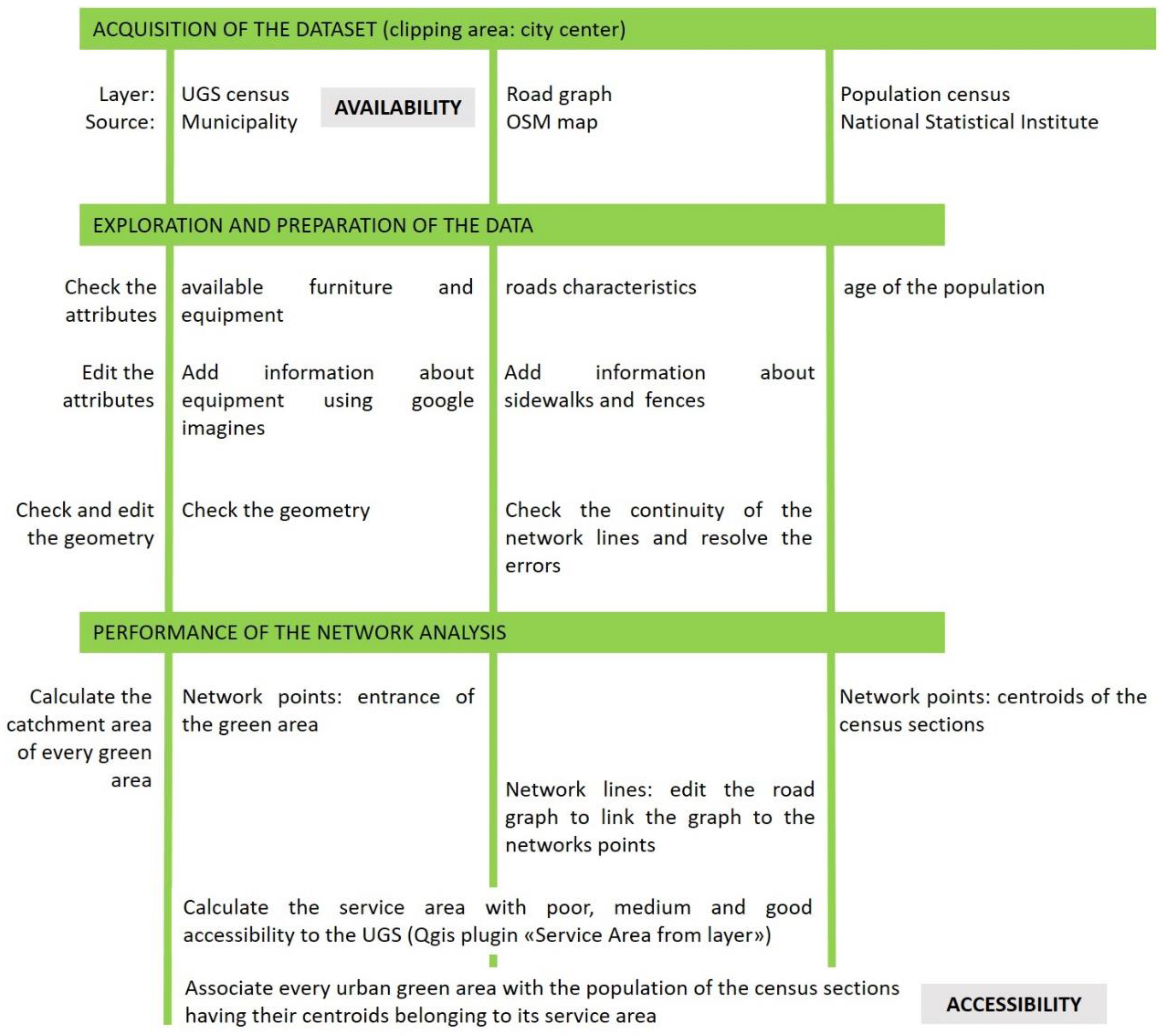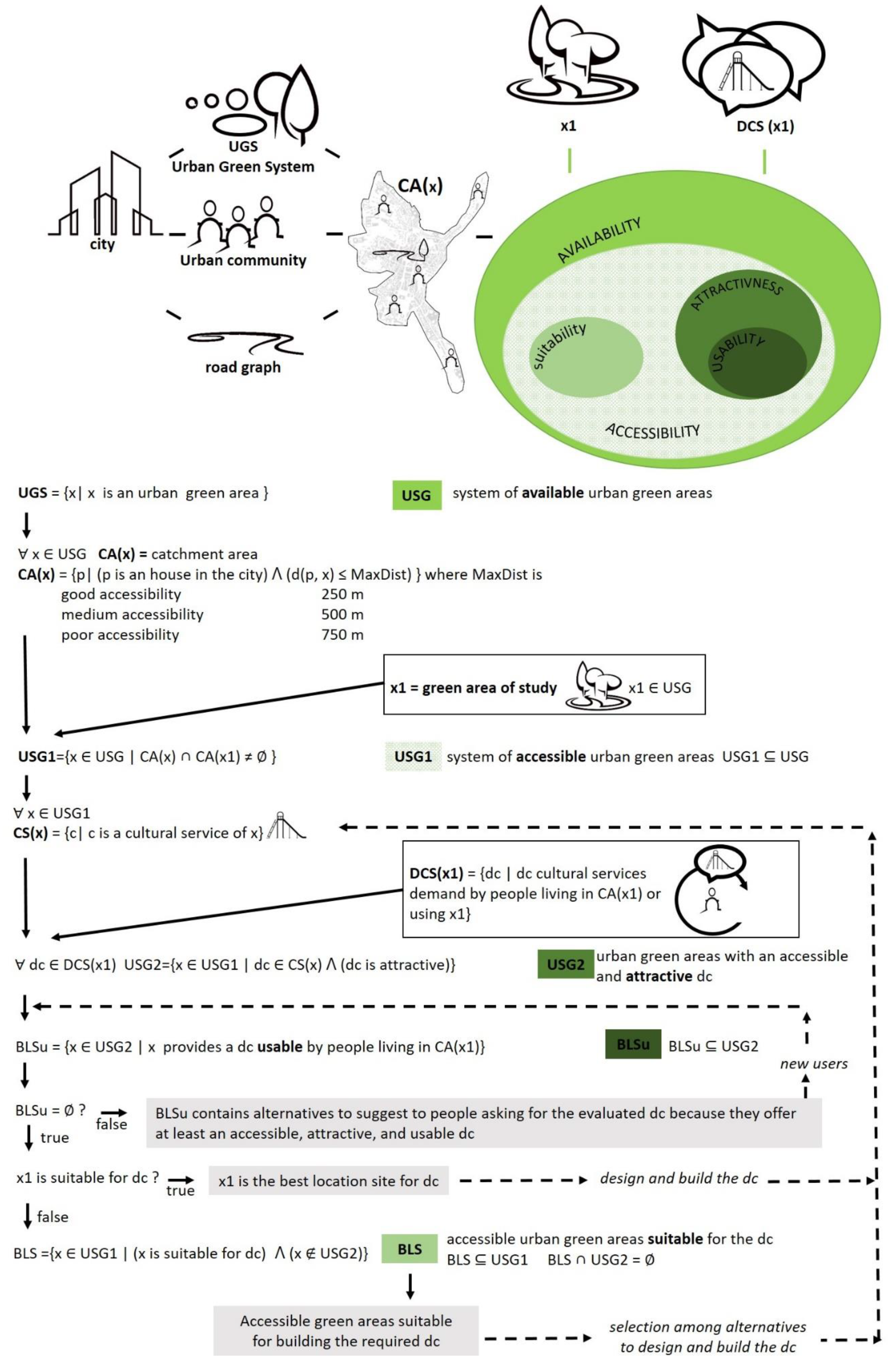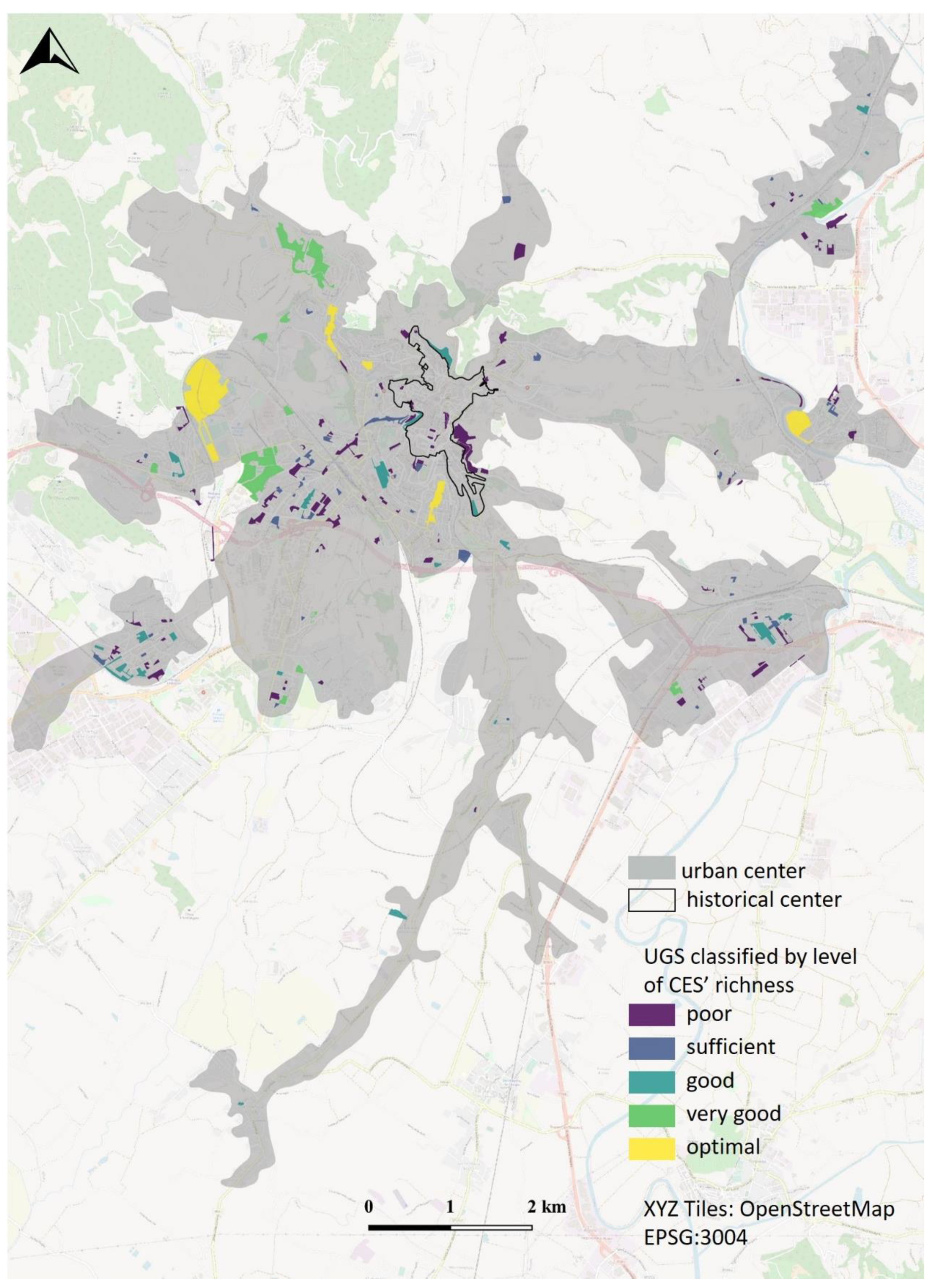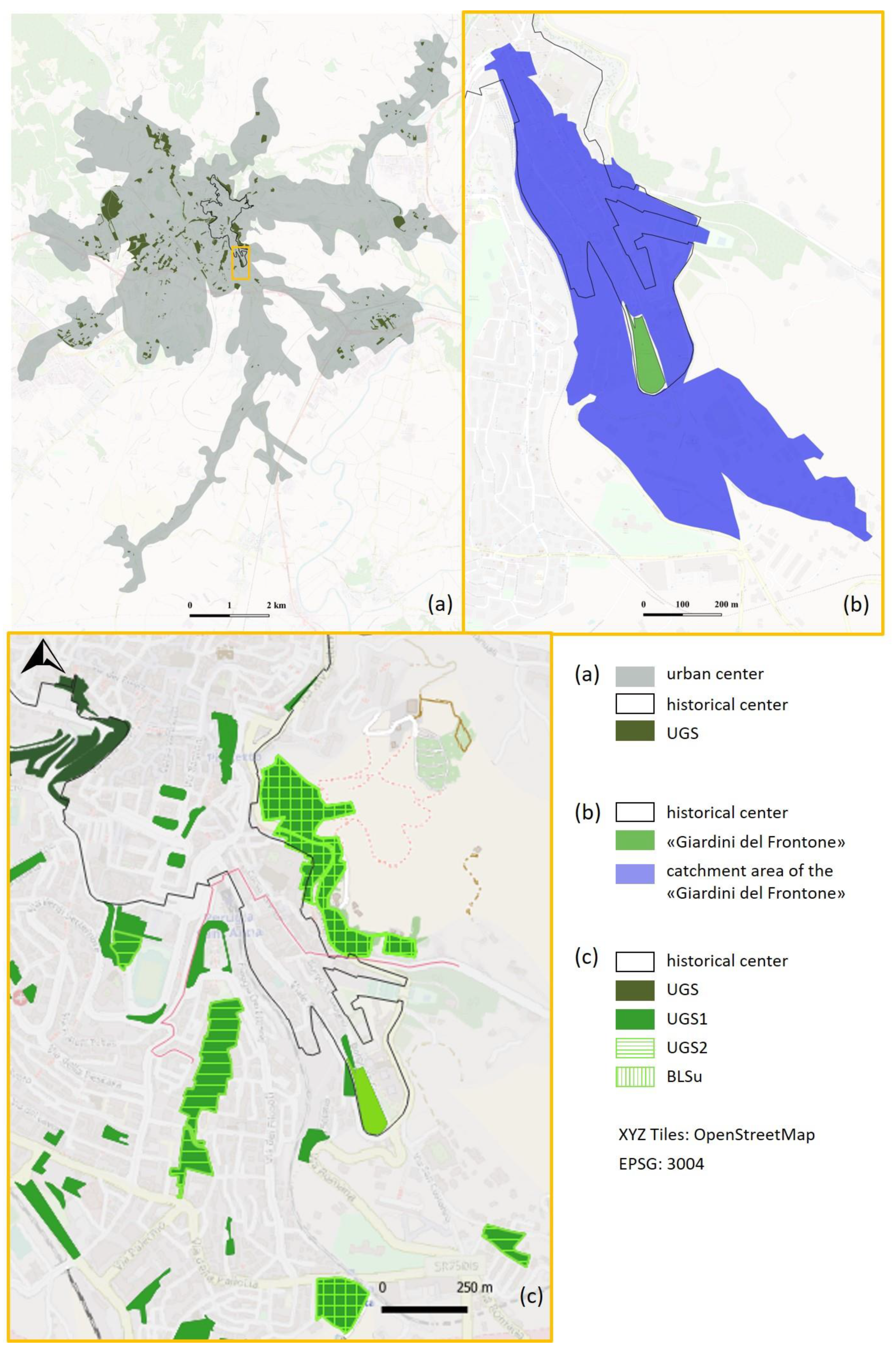Complex Systems Thinking Approach to Urban Greenery to Provide Community-Tailored Solutions and Enhance the Provision of Cultural Ecosystem Services
Abstract
:1. Introduction
1.1. Urban Greenery as a Complex System
1.2. Criteria for Balancing the Supply of Urban Green Areas with Citizens’ Demands of CES
1.3. Case Study
2. Materials and Methods
- -
- Availability. Is there an existing urban green area within the system that provides the requested cultural services? What distance is it from x1?
- -
- Accessibility. Are the available CES reachable by pedestrians using safe roads with no barriers (including architectural barriers, high-traffic roads, difficult crossings, fences, crossing of private property, opening hours, entrance fees)?
- -
- Attractiveness. Are the available CES attractive? Is the quality and appearance of their equipment and surroundings satisfactory?
- -
- Usability. Can the accessible cultural services increase their catchment area without compromising their usability? Are they currently under-used?
- -
- Suitability. Is the x1 area suitable for its provision? Is there adequate space to realize the necessary equipment to provide the service? Are there any current uses of the green area or neighboring areas that could be in conflict with the new service?
Steps of the Method
3. Results
3.1. Results at the City Level
3.2. Renewal of the Green Area “Giardini del Frontone”. Results at the Neighborhood and Green Area Levels
4. Discussion
4.1. Discussion of the Case Study Results
4.2. Highlights of the Method in Considering the Complexity of the UGS
5. Conclusions
Author Contributions
Funding
Institutional Review Board Statement
Informed Consent Statement
Conflicts of Interest
References
- KEA European Affairs. The Impact of the COVID19 Pandemic on the Cultural and Creative Sector. Report for the Council of Europe. 2020. Available online: https://keanet.eu/wp-content/uploads/Impact-of-COVID-19-pandemic-on-CCS_COE-KEA_26062020.pdf.pdf (accessed on 5 September 2021).
- Sharifi, A.; Khavarian-Garmsir, A.R. The COVID-19 pandemic: Impacts on cities and major lessons for urban planning, design, and management. Sci. Total Environ. 2020, 749. [Google Scholar] [CrossRef] [PubMed]
- Honey-Rosés, J.; Anguelovski, I.; Chireh, V.K.; Daher, C.; Bosch, C.K.V.D.; Litt, J.S.; Mawani, V.; McCall, M.K.; Orellana, A.; Oscilowicz, E.; et al. The impact of COVID-19 on public space: An early review of the emerging questions—Design, perceptions and inequities. Cities Health 2020. [Google Scholar] [CrossRef]
- Menconi, M.; Heland, L.; Grohmann, D. Learning from the gardeners of the oldest community garden in Seattle: Resilience explained through ecosystem services analysis. Urban For. Urban Green 2020, 56, 126878. [Google Scholar] [CrossRef]
- Zhu, J.; Xu, C. Sina microblog sentiment in Beijing city parks as measure of demand for urban green space during the COVID-19. Urban For. Urban Green 2020, 58. [Google Scholar] [CrossRef]
- Ugolini, F.; Massetti, L.; Calaza-Martínez, P.; Cariñanos, P.; Dobbs, C.; Ostoić, S.K.; Marin, A.M.; Pearlmutter, D.; Saaroni, H.; Šaulienė, I.; et al. Effects of the COVID-19 pandemic on the use and perceptions of urban green space: An international exploratory study. Urban For. Urban Green 2020, 56. [Google Scholar] [CrossRef] [PubMed]
- Ma, A.T.; Lam, T.W.; Cheung, L.T.; Fok, L. Protected areas as a space for pandemic disease adaptation: A case of COVID-19 in Hong Kong. Landsc. Urban Plan. 2020, 207. [Google Scholar] [CrossRef]
- Menconi, M.; Tasso, S.; Santinelli, M.; Grohmann, D. A card game to renew urban parks: Face-to-face and online approach for the inclusive involvement of local community. Eval. Program Plan. 2019, 79. [Google Scholar] [CrossRef] [PubMed]
- Biernacka, M.; Kronenberg, J. Classification of institutional barriers affecting the availability, accessibility and attractiveness of urban green spaces. Urban For. Urban Green 2018, 36, 22–33. [Google Scholar] [CrossRef]
- Biernacka, M.; Kronenberg, J.; Łaszkiewicz, E. An integrated system of monitoring the availability, accessibility and attractiveness of urban parks and green squares. Appl. Geogr. 2020, 116. [Google Scholar] [CrossRef]
- Lahoti, S.; Lahoti, A.; Saito, O. Benchmark assessment of recreational public Urban Green space provisions: A case of typical urbanizing Indian City, Nagpur. Urban For. Urban Green 2019, 44. [Google Scholar] [CrossRef]
- Artmann, M.; Mueller, C.; Goetzlich, L.; Hof, A. Supply and Demand Concerning Urban Green Spaces for Recreation by Elderlies Living in Care Facilities: The Role of Accessibility in an Explorative Case Study in Austria. Front. Environ. Sci. 2019. [Google Scholar] [CrossRef]
- Chen, J.; Chang, Z. Rethinking urban green space accessibility: Evaluating and optimizing public transportation system through social network analysis in megacities. Landsc. Urban Plan. 2015, 143, 150–159. [Google Scholar] [CrossRef]
- Wanghe, K.; Guo, X.; Luan, X.; Li, K. Assessment of Urban Green Space Based on Bio-Energy Landscape Connectivity: A Case Study on Tongzhou District in Beijing, China. Sustainability 2019, 11, 4943. [Google Scholar] [CrossRef] [Green Version]
- Wang, B.; Liu, Z.; Mei, Y.; Li, W. Assessment of Ecosystem Service Quality and Its Correlation with Landscape Patterns in Haidian District, Beijing. Int. J. Environ. Res. Public Health 2019, 16, 1248. [Google Scholar] [CrossRef] [PubMed] [Green Version]
- Mahmoudkhani, M.; Feghhi, J.; Makhdoum, M.; Bahmani, O. Evaluation of the recreational capability and designing of the woodsy promenade. Environ. Dev. Sustain. 2020, 23, 8062–8075. [Google Scholar] [CrossRef]
- Dade, M.C.; Mitchell, M.G.; Brown, G.; Rhodes, J.R. The effects of urban greenspace characteristics and socio-demographics vary among cultural ecosystem services. Urban For. Urban Green 2020, 49. [Google Scholar] [CrossRef]
- Hong, W.; Guo, R. Indicators for quantitative evaluation of the social services function of urban greenbelt systems: A case study of shenzhen, China. Ecol. Indic. 2017, 75, 259–267. [Google Scholar] [CrossRef]
- Schäffler, A.; Swilling, M. Valuing green infrastructure in an urban environment under pressure The Johannesburg case. Ecol. Econ. 2013, 86, 246–257. [Google Scholar] [CrossRef]
- Subramanian, D.; Jana, A. Evaluating the cultural ecosystem services of India: Comparison of budget allocations to improve the use value of recreational open spaces. Ecosyst. Serv. 2019, 38. [Google Scholar] [CrossRef]
- Cilliers, E.J.; Timmermans, W.; Goorbergh, F.V.D.; Slijkhuis, J.S.A. The Story Behind the Place: Creating Urban Spaces That Enhance Quality of Life. Appl. Res. Qual. Life 2014, 10, 589–598. [Google Scholar] [CrossRef]
- Matasov, V.; Marchesini, L.B.; Yaroslavtsev, A.; Sala, G.; Fareeva, O.; Seregin, I.; Castaldi, S.; Vasenev, V.; Valentini, R. IoT Monitoring of Urban Tree Ecosystem Services: Possibilities and Challenges. Forests 2020, 11, 775. [Google Scholar] [CrossRef]
- Ferrini, F.; Fini, A.; Mori, J.; Gori, A. Role of Vegetation as a Mitigating Factor in the Urban Context. Sustainability 2020, 12, 4247. [Google Scholar] [CrossRef]
- MEA. Ecosystems and Human Well-Being: A Framework for Assessment; Island Press: Washington, DC, USA, 2005; pp. 25–36. [Google Scholar]
- Kronenberg, J.; Haase, A.; Łaszkiewicz, E.; Antal, A.; Baravikova, A.; Biernacka, M.; Dushkova, D.; Filčak, R.; Haase, D.; Ignatieva, M.; et al. Environmental justice in the context of urban green space availability, accessibility, and attractiveness in postsocialist cities. Cities 2020, 106. [Google Scholar] [CrossRef]
- Feltynowski, M.; Kronenberg, J.; Bergier, T.; Kabisch, N.; Łaszkiewicz, E.; Strohbach, M. Challenges of urban green space management in the face of using inadequate data. Urban For. Urban Green 2018, 31, 56–66. [Google Scholar] [CrossRef]
- United Nations. Goal 11. Make Cities and Human Settlements Inclusive, Safe, Resilient and Sustainable. Available online: https://sdgs.un.org/goals/goal11 (accessed on 16 October 2020).
- Hegetschweiler, T.; de Vries, S.; Arnberger, A.; Bell, S.; Brennan, M.; Siter, N.; Olafsson, A.; Voigt, A.; Hunziker, M. Linking demand and supply factors in identifying cultural ecosystem services of urban green infrastructures: A review of European studies. Urban For. Urban Green 2017, 21, 48–59. [Google Scholar] [CrossRef] [Green Version]
- Akpinar, A. Factors influencing the use of urban greenways: A case study of Aydin, Turkey. Urban For. Urban Green 2016, 16, 123–131. [Google Scholar] [CrossRef]
- Grunewald, K.; Richter, B.; Meinel, G.; Herold, H.; Syrbe, R.-U. Proposal of indicators regarding the provision and acces-sibility of green spaces for assessing the ecosystem service “recreation in the city” in Germany. Int. J. Biodivers. Sci. Ecosyst. Serv. Manag. 2017, 13, 26–39. [Google Scholar] [CrossRef] [Green Version]
- Koltsova, A.; Kunze, A.; Schmitt, G. Design of Urban Space at Pedestrian Scale: A Method for Parameterization of Urban Qualities. In Proceedings of the 2012 16th International Conference on Information Visualisation (IV), Montpellier, France, 11–13 July 2012; pp. 403–409. [Google Scholar] [CrossRef]
- Meerow, S.; Newell, J.P. Spatial planning for multifunctional green infrastructure: Growing resilience in Detroit. Landsc. Urban Plan. 2017, 159, 62–75. [Google Scholar] [CrossRef]
- Ragab, K. Quantitavive Evaluation of distribution and accessibility of urban green space. Case Study: City of Jeddah. Int. J. Geomat. Geosci. 2014, 3, 526–535. [Google Scholar]
- Kaczynski, A.T.; Schipperijn, J.; Hipp, J.A.; Besenyi, G.M.; Wilhelm Stanis, S.A.; Hughey, S.M.; Wilcox, S. ParkIndex: Devel-opment of a standardized metric of park access for research and planning. Prev. Med. 2016, 87, 110–114. [Google Scholar] [CrossRef] [PubMed]
- Kimpton, A. A spatial analytic approach for classifying greenspace and comparing greenspace social equity. Appl. Geogr. 2017, 82, 129–142. [Google Scholar] [CrossRef] [Green Version]
- Park, K. Psychological park accessibility: A systematic literature review of perceptual components affecting park use. Landsc. Res. 2016, 42, 508–520. [Google Scholar] [CrossRef]
- Łaszkiewicz, E.; Czembrowski, P.; Kronenberg, J. Can proximity to urban green spaces be considered a luxury? Classifying a non-tradable good with the use of hedonic pricing method. Ecol. Econ. 2019, 161, 237–247. [Google Scholar] [CrossRef]
- Ståhle, A. Sociotope mapping: Exploring public open space and its multiple use values in urban and landscape planning practice. Nord. J. Archit. Res. 2006, 19, 59–71. [Google Scholar]
- Richards, D.R.; Tuncer, B. Using image recognition to automate assessment of cultural ecosystem services from social media photographs. Ecosyst. Serv. 2018, 31, 318–325. [Google Scholar] [CrossRef]
- Zhang, S.; Zhou, W. Recreational visits to urban parks and factors affecting park visits: Evidence from geotagged social media data. Landsc. Urban Plan. 2018, 180, 27–35. [Google Scholar] [CrossRef]
- Heikinheimo, V.; Tenkanen, H.; Bergroth, C.; Järv, O.; Hiippala, T.; Toivonen, T. Understanding the use of urban green spaces from user-generated geographic information. Landsc. Urban Plan. 2020, 201. [Google Scholar] [CrossRef]
- Elliott, R.M.; Motzny, A.E.; Majd, S.; Chavez, F.V.; Laimer, D.; Orlove, B.S.; Culligan, P.J. Identifying linkages between urban green infrastructure and ecosystem services using an expert opinion methodology. Ambio 2019, 49, 569–583. [Google Scholar] [CrossRef] [PubMed]
- Demographic Statistic ISTAT. Available online: http://demo.istat.it/bilmens/index.php?anno=2020&lingua=ita (accessed on 5 September 2021).
- Martinico, F.; La Rosa, D.; Privetera, R. Green oriented urban development for urban ecosystem services provision in a medium sized city in southern Italy. iForest 2014, 7, 385–395. [Google Scholar] [CrossRef] [Green Version]
- Municipality of Perugia. Municipal Census of Urban green areas (Portale Ambiente). Available online: http://ambiente.comune.perugia.it/#Temi%20Ambientali (accessed on 5 September 2021).
- Population Census. Available online: https://www.istat.it/it/archivio/104317 (accessed on 5 September 2021).
- Fondazione Veronesi. Available online: https://www.fondazioneveronesi.it/magazine/articoli/cardiologia/un-buon-passo-fa-la-differenza-la-salute-di-un-anziano (accessed on 5 September 2021).
- Italian Ministry of Ecological Transition. L. 10/2013. Available online: https://www.mite.gov.it/sites/default/files/archivio/normativa/legge_14_01_2013_10.pdf (accessed on 5 September 2021).
- Italian Official Gazette. D.M. 63/2020. Available online: https://www.mite.gov.it/sites/default/files/archivio/allegati/GPP/2020/guri_dm_63_del_2020_verde_002.pdf (accessed on 5 September 2021).
- ISTAT. Urban Environment. Urban Greenery: Table 11.1 (Availability of Urban Green Area per Person). Available online: https://www.istat.it/it/archivio/236912 (accessed on 5 September 2021).
- Italian Official Gazette. DM 1444/68. Available online: https://www.gazzettaufficiale.it/eli/id/1968/04/16/1288Q004/sg (accessed on 5 September 2021).
- Boulton, C.; Dedekorkut-Howes, A.; Byrne, J. Factors shaping urban greenspace provision: A systematic review of the literature. Landsc. Urban Plan. 2018, 178, 82–101. [Google Scholar] [CrossRef]
- Ramn, F.; Topf, J.; Chilton, S. OpenStreetMap—Using and Enhancing the Free Map of the World; UIT Cambridge Ltd.: Cambridge, UK, 2014. [Google Scholar]
- Gerstenberg, T.; Baumeister, C.F.; Schraml, U.; Plieninger, T. Hot routes in urban forests: The impact of multiple landscape features on recreational use intensity. Landsc. Urban Plan. 2020, 203. [Google Scholar] [CrossRef]
- Menconi, M.E.; Palazzoni, L.; Grohmann, D. Core themes for an urban green systems thinker: A review of complexity man-agement in provisioning cultural ecosystem services. Urban For. Urban Green 2021, 127355. [Google Scholar] [CrossRef]
- Support Google. Available online: https://support.google.com/business/answer/6263531?hl=en# (accessed on 5 September 2021).
- Derks, J.; Giessen, L.; Winkel, G. COVID-19-induced visitor boom reveals the importance of forests as critical infrastructure. For. Policy Econ. 2020, 118, 102253. [Google Scholar] [CrossRef]
- Foster, K. Geodesign parsed: Placing it within the rubric of recognized design theories. Landsc. Urban Plan. 2016, 156, 92–100. [Google Scholar] [CrossRef] [Green Version]





| Accessibility | Good | Medium | Poor | Total | |
| Services’ Richness | |||||
| poor | 5.11 | 6.91 | 5.51 | 17.53 | |
| sufficient | 15.82 | 8.47 | 3.37 | 27.66 | |
| good | 6.39 | 2.1 | 2.99 | 11.48 | |
| very good | 11.29 | 0.95 | 0.29 | 12.53 | |
| optimal | 6.53 | 3.85 | 2.45 | 12.83 | |
| Total | 45.14 | 22.28 | 14.61 | ||
| % of the population with access to at least one green area providing CES | 82.03 | ||||
| % of the population without access to at least one green area providing CES | 17.97 | ||||
Publisher’s Note: MDPI stays neutral with regard to jurisdictional claims in published maps and institutional affiliations. |
© 2021 by the authors. Licensee MDPI, Basel, Switzerland. This article is an open access article distributed under the terms and conditions of the Creative Commons Attribution (CC BY) license (https://creativecommons.org/licenses/by/4.0/).
Share and Cite
Menconi, M.E.; Sipone, A.; Grohmann, D. Complex Systems Thinking Approach to Urban Greenery to Provide Community-Tailored Solutions and Enhance the Provision of Cultural Ecosystem Services. Sustainability 2021, 13, 11787. https://doi.org/10.3390/su132111787
Menconi ME, Sipone A, Grohmann D. Complex Systems Thinking Approach to Urban Greenery to Provide Community-Tailored Solutions and Enhance the Provision of Cultural Ecosystem Services. Sustainability. 2021; 13(21):11787. https://doi.org/10.3390/su132111787
Chicago/Turabian StyleMenconi, Maria Elena, Ambra Sipone, and David Grohmann. 2021. "Complex Systems Thinking Approach to Urban Greenery to Provide Community-Tailored Solutions and Enhance the Provision of Cultural Ecosystem Services" Sustainability 13, no. 21: 11787. https://doi.org/10.3390/su132111787
APA StyleMenconi, M. E., Sipone, A., & Grohmann, D. (2021). Complex Systems Thinking Approach to Urban Greenery to Provide Community-Tailored Solutions and Enhance the Provision of Cultural Ecosystem Services. Sustainability, 13(21), 11787. https://doi.org/10.3390/su132111787







